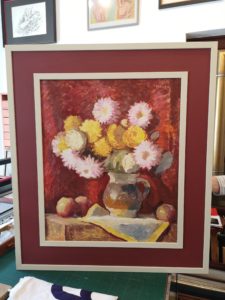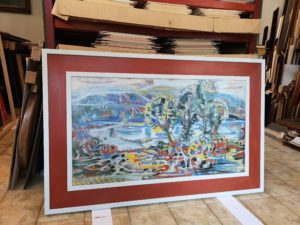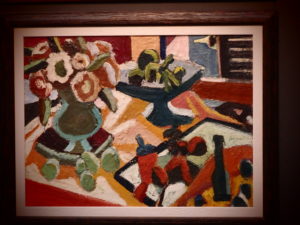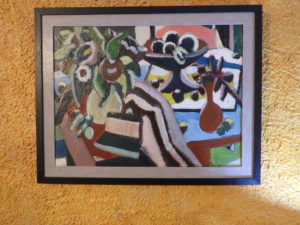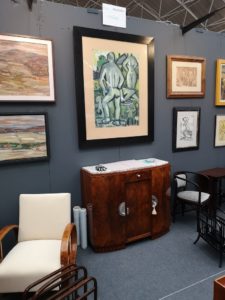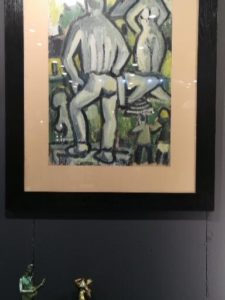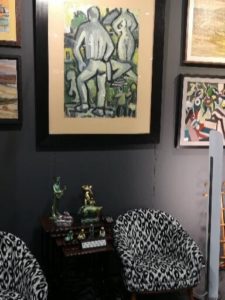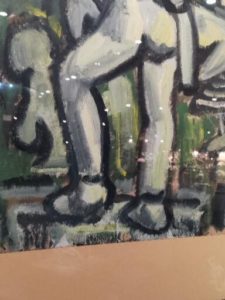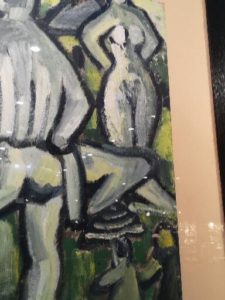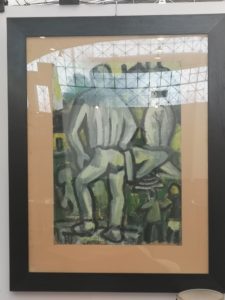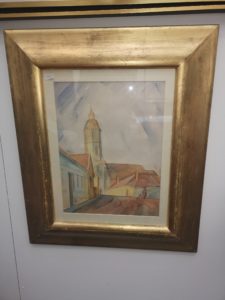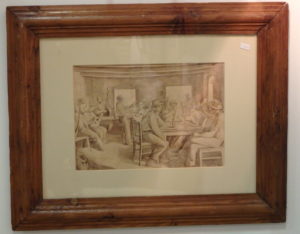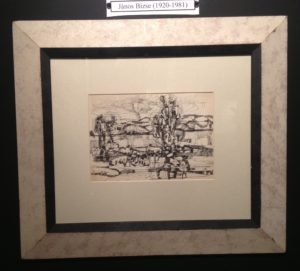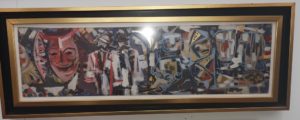Vase with flowers by Gábor Jenő (1893-1968), oil on cardboard with hand-painted wooden frame. Born in Pècs in 1893, Gábor Jenő attended the Academy of Fine Arts in Budapest from 1911 to 1915. At the end of the war, he left with a group of other Pècs artists to go to Germany to participate in the Bauhaus movement, his companions trip were: Breuer Marcell, Forbát Alfréd, Molnár Farkas and Weininger Andor.
Gábor Jenő was strongly influenced by all the great European movements, in particular by Cubism and Expressionism, with a particular attention to Cezanne’s painting, which he could admire in his Parisian stays. 50 x 70 cm.
Orfű lake, Bizse Jànos (1920 – 1981)
The painting is an oil on canvas characterized by a particular technique that we could define as a “mosaic”, in which the pictorial scene is obtained through a precise method of recomposition of the numerous colored tesserae in which the real image had been “de-structured” of reference. His painting could also be interpreted as a particular mosaicist variant of the then emerging optical-art.
Bizse Janos was born in Pècs, Hungary in 1920 where he died in 1981. He has exhibited his works in numerous countries, including Italy, Yugoslavia, the Soviet Union, France. Many of his works have been sold by the most important galleries in Hungary and he is present with his works in several
museums. He has also developed numerous wall sculptures, real mosaics in several Hungarian cities including Komlo and Pècs. The frame is hand-painted wood. 60 x 90 cm. Age 1969.
Still life, Hajdú Katalin (Szolnok 1932 -). Oil on cardboard which portrays a rich and composite still life. The depiction presents a double perspective in the manner of the Cubists and is a typical production of the 60s. Having graduated from the Academy of Budapest in the 1950s, Hajdú Katalin has exhibited his works in numerous galleries and has traveled frequently in France. Solo exhibitions: 1964, Mednyánszky Terem, Budapest, 1966, Fészek Klub, Budapest. 90 x 75 cm.
Back man, Miklos Németh (1934-2012). Oil on cardboard depicting a man from the back, neorealist painting by Miklos Németh, a very prolific Hungarian painter who has exhibited in numerous countries from Japan to the United States and which is treated by numerous auction houses ..
The impressionism in the 1920s of Paul Cézanne, Pablo Picasso and cubism after 1945, were the inspirers of the neorealist painters gathered in the “New Front of the Arts” united by the common “need to express reality through the renewal of language” . Németh’s painting is characterized by broad brush strokes and very bright colors. The painting is from the 60s in its original state with its solid wood frame.
Streets of Pècs by Gábor Jenő (1893-1968), watercolor on cardboard with gilded wooden frame. Born in Pècs in 1893, Gábor Jenő attended the Academy of Fine Arts in Budapest from 1911 to 1915. At the end of the war, he left with a group of other Pècs artists to go to Germany to participate in the Bauhaus movement, his companions trip were: Breuer Marcell, Forbát Alfréd, Molnár Farkas and Weininger Andor.
Gábor Jenő was strongly influenced by all the great European movements, in particular by Cubism and Expressionism, with a particular attention to Cezanne’s painting, which he could admire in his Parisian stays. 50 x 70 cm.
Tavern (Csárda), watercolor on cardboard by Gábor Jenő (1893-1968). Watercolor on cardboard depicting a Hungarian Csárda where a group of musicians entertains the patrons. The frame is an old Biedermeier mirror cleaned of gilding. Born in Pècs in 1893, Gábor Jenő attended the Academy of Fine Arts in Budapest from 1911 to 1915. At the end of the war, he left with a group of other Pècs artists to go to Germany to participate in the Bauhaus movement, his companions trip were: Breuer Marcell, Forbát Alfréd, Molnár Farkas and Weininger Andor.
Gábor Jenő was heavily influenced by all the great European movements, in particular Cubism and Expressionism, with particular attention to Cezanne’s painting, which he could admire in his Parisian stays. 65 x 50 cm. Age 1940.
Preparatory sketch of landscapes, Bizse Jànos (1920 – 1981). The drawing is an ink on cardboard characterized by a particular technique that we could define as a “mosaic”, in which the pictorial scene is obtained through a precise method of recomposition of the numerous colored tesserae in which the real image had been “de-structured” of reference. His painting could also be interpreted as a particular mosaicist variant of the then emerging optical-art.
Bizse Janos was born in Pècs, Hungary in 1920 where he died in 1981. He has exhibited his works in numerous countries, including Italy, Yugoslavia, the Soviet Union, France. Many of his works have been sold by the most important galleries in Hungary and he is present with his works in several
museums. He has also developed numerous wall sculptures, real mosaics in several Hungarian cities including Komlo and Pècs. The frame is hand-painted wood. 50 x 30 cm Age 1950.
Tempera on cardboard with gold-colored inserts by Bizse Jànos (1920 – 1981) depicting a popular carnival, characterized by a particular technique that we could define as a “mosaic”, in which the pictorial scene is obtained through a precise method of recomposition of the numerous colored tiles in which the real reference image had been “de-structured”. His painting could also be interpreted as a particular mosaicist variant of the then emerging optical-art.
Bizse Janos was born in Pècs, Hungary in 1920 where he died in 1981. He has exhibited his works in numerous countries, including Italy, Yugoslavia, the Soviet Union, France. Many of his works have been sold by the most important galleries in Hungary and he is present with his works in several
museums. He has also developed numerous wall sculptures, real mosaics in several Hungarian cities including Komlo and Pècs. The frame is hand-painted wood. 80 x 25 cm. Age 1950.

